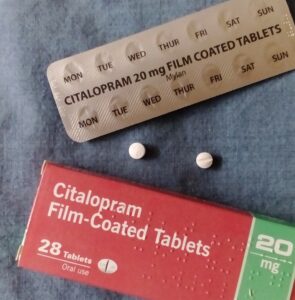Depression is a serious mental illness that can impact all aspects of a person’s life. Symptoms can include sadness, emptiness, hopelessness, fatigue, irritability, and changes in sleeping and eating habits. If you are struggling with depression, it is important to get help.
There are many different types of medication available to treat depression, and Citalopram (Celexa) is one of them. In this guide, we will discuss citalopram and its uses in the treatment of depression.
Contents
- 1 What Is Citalopram?
- 2 What Does Citalopram Treat?
- 3 How Should I Take Citalopram?
- 4 What Symptoms Does Citalopram Treat?
- 5 How Does Citalopram Work?
- 6 How Citalopram Is Taken?
- 7 Side Effects of Citalopram
- 8 How to Control Side Effects of Citalopram
- 9 Alternatives of Citalopram
- 10 Conclusion
- 11 A Word From Therapy Mantra
What Is Citalopram?

Citalopram is an antidepressant that is approved by the FDA to treat the major depressive disorder in adults. It is also sometimes used “off-label” for other conditions, such as anxiety disorders, eating disorders, and obsessive-compulsive disorder (OCD).
Citalopram belongs to a class of antidepressants known as selective serotonin reuptake inhibitors (SSRIs). SSRIs work by increasing levels of serotonin in the brain. Serotonin is a neurotransmitter that plays an important role in mood and mental health.
What Does Citalopram Treat?
Citalopram treats major depressive disorder. It can also use to treat anxiety disorders, obsessive-compulsive disorder (OCD), panic attacks, post-traumatic stress disorder (PTSD), and premenstrual dysphoric disorder (PMDD). It works by increasing the levels of serotonin, a natural substance in the brain that helps maintain mental balance.
- Obsessive-Compulsive Disorder: Citalopram uses to treat obsessive-compulsive disorder (OCD). It may decrease fear, anxiety, unwanted thoughts, and the number of times you act on these thoughts.
- Panic Attacks: Citalopram is used to treat panic attacks. It may help you think more clearly, relax, worry less, and take part in everyday life. It may also decrease how often you have panic attacks.
- Post-Traumatic Stress Disorder: Citalopram is used to treat post-traumatic stress disorder (PTSD). It may help reduce fear, anxiety, unwanted thoughts, and flashbacks.
- Premenstrual Dysphoric Disorder: Citalopram is used to treat premenstrual dysphoric disorder (PMDD). It may help reduce feelings of depression, irritability, and tension before your period begins.
How Should I Take Citalopram?

Citalopram comes as a tablet and a solution (liquid) to take by mouth. It is usually taken once daily with or without food. To help you remember to take citalopram, take it at around the same time every day. Follow the directions on your prescription label carefully, and ask your doctor or pharmacist to explain any part you do not understand. Take the medication exactly as directed. Do not take more or less of it or take it more often than prescribed by your doctor.
You may begin to feel better within a few weeks after you start taking citalopram; however, it may take up to several months for you to feel the full benefit of the medication. Continue to take citalopram even if you feel well. Do not stop taking citalopram without talking to your doctor, even if you experience side effects such as unusual changes in behavior or mood, an increase in anxiety, hostility, agitation, restlessness, hyperactivity (mentally or physically), and more depression, or thoughts about suicide.
What Symptoms Does Citalopram Treat?

Citalopram can help relieve symptoms of depression such as:
- Feeling sad or empty
- Loss of interest or pleasure in activities you normally enjoy
- Changes in appetite or weight
- Sleeping too much or too little
- Loss of energy
- Feelings of worthlessness or guilt
- Difficulty concentrating, remembering, or making decisions
- Thoughts of death or suicide
Citalopram may also use for purposes not listed in this medication guide. If you are taking citalopram, your healthcare provider will likely start you on a low dose and gradually increase it as needed.
How Does Citalopram Work?

It works by increasing the levels of serotonin in the brain. Serotonin is one of the neurotransmitters, or brain chemicals, that play a role in mood. By increasing serotonin levels, citalopram helps to relieve depression and anxiety symptoms.
It is thought to work by inhibiting the reuptake of serotonin into nerve cells. This action increases the level of serotonin in the spaces between nerves (synapses), which enhances serotonin’s action at nerve receptors.
In addition to its mood-boosting effects, citalopram also has other benefits. So, it can help relieve hot flashes and improve sleep in menopausal women. It may also help treat other conditions, such as fibromyalgia, migraines, Irritable Bowel Syndrome (IBS), and premature ejaculation.
How Long Does It Take To Work?
The medication nearly takes full effect within one to two weeks. The most common side effects are dry mouth, drowsiness, insomnia, and nausea. These usually go away after a few days or weeks of treatment.
Citalopram should not take with monoamine oxidase inhibitors (MAOIs). MAOIs are a class of antidepressants that includes phenelzine (Nardil) and tranylcypromine (Parnate). Taking citalopram with MAOIs can cause a dangerous reaction with symptoms such as high fever, sweating, muscle stiffness, rapid heartbeat, changes in blood pressure, and delirium. If you have taken an MAOI within the past 14 days, wait at least 14 days before taking citalopram.
How Citalopram Is Taken?
You can take Citalopram in:
- Tablet Form: You should take Citalopram with food and water. Swallow the tablet whole; do not chew, break, or crush it.
And, if you miss a dose of Celexa, take it as soon as possible. If it is almost time for your next dose, skip the missed dose and go back to your regular dosing schedule. Do not take two doses at once unless otherwise directed by your healthcare provider.
- Liquid Form: The oral solution is available in a strength of citalopram base of 20 mg/mL. The recommended starting dose of the oral solution in adult patients with MDD or GAD is 20 mg/day administered in the morning or evening prior
Side Effects of Citalopram

There are few side effects that people experience when taking citalopram. The most common ones include:
- Nausea: This is usually the first side effect that people experience when they start taking. It typically goes away after a few weeks of treatment.
- Dry mouth: This is a bothersome side effect, but it is not dangerous. Drinking plenty of fluids and chewing sugarless gum can help alleviate this symptom.
- Headache: Headaches are a common side effect of many medications, and citalopram is no exception. If you experience headaches while taking citalopram, talk to your doctor about other possible treatments.
- Fatigue: Fatigue is another common side effect of citalopram. If you find that your fatigue is severe or interferes with your daily activities, talk to your doctor about other possible
- Vomiting: Although nausea is a more common side effect of citalopram, some people may experience vomiting. If you vomit more than once a day or if your vomit contains blood, contact your doctor immediately.
- Diarrhea: Diarrhea is another possible side effect of citalopram. If you have diarrhea that is severe or lasts for more than a few days, contact your doctor.
Citalopram may also cause other side effects. If you experience any unusual symptoms while taking it, be sure to contact your doctor.
The medication is generally well-tolerated by most people. The most common side effects are usually mild and go away after a few weeks of treatment. However, there are these symptoms, stop taking citalopram and seek medical help immediately.
How to Control Side Effects of Citalopram

- There are many ways by which people can control the side effects of citalopram. The first thing that a person needs to do is to take the medicine as prescribed by the doctor. One should not skip or change the dose without consulting the doctor.
- Secondly, people need to give some time for their bodies to get used to the medication before they see any positive results from it. Lastly, if a person experiences any negative side effects, they should consult their doctor immediately so that he can prescribe a different dosage or medication.
- One of the most common side effects is dry mouth. To combat this, individuals can drink more fluids throughout the day, chew sugar-free gum, or use artificial saliva products. Other possible side effects include constipation, diarrhea, weight changes, and sexual difficulties.
- Most of these side effects are mild and go away on their own after a person adjusts to the medication. However, if any of these side effects persist or become bothersome, it is important to consult a doctor.
- It is a very effective medication for treating depression. So, with proper care and guidance, people can control the side effects so that they can live happier and healthier lives.
Alternatives of Citalopram
There are many alternatives to citalopram that can be used to treat depression. Some of these include:
- Zoloft
- Paxil
- Prozac
- Bupropion
- Duloxetine
- Aripiprazole
Conclusion
In conclusion, citalopram (Celexa) is a very effective medication for treating depression. It can use on its own or in combination with other medications. If you are considering taking Celexa, be sure to speak with your doctor about all of your options. They will help you decide if Celexa is the right medication for you.
If you are currently taking Celexa, make sure to follow your doctor’s instructions and take the medication as prescribed. Do not stop taking Celexa without speaking to your doctor first, as this can cause serious side effects.
A Word From Therapy Mantra
Your mental health — Your psychological, emotional, and social well-being — has an impact on every aspect of your life. Positive mental health essentially allows you to effectively deal with life’s everyday challenges.
At TherapyMantra, we have a team of therapists who provide affordable online therapy to assist you with issues such as depression, anxiety, stress, workplace Issues, addiction, relationship, OCD, LGBTQ, and PTSD. You can book a free therapy or download our free Android or iOS app.


